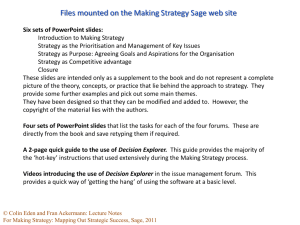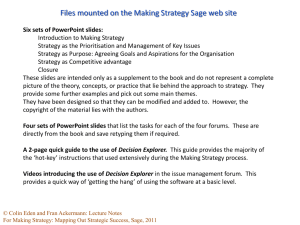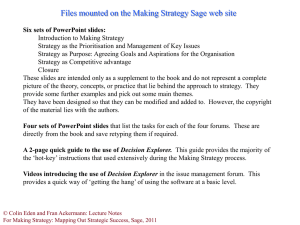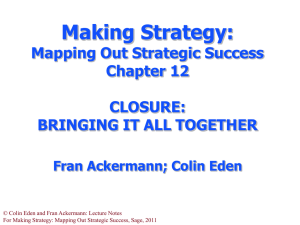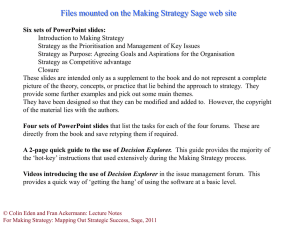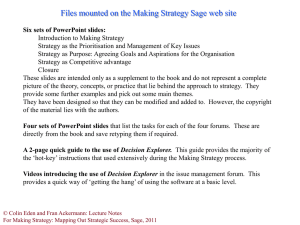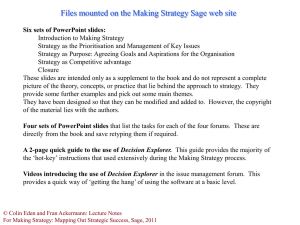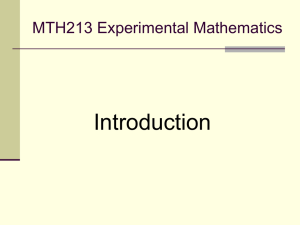Introduction to Making Strategy
advertisement
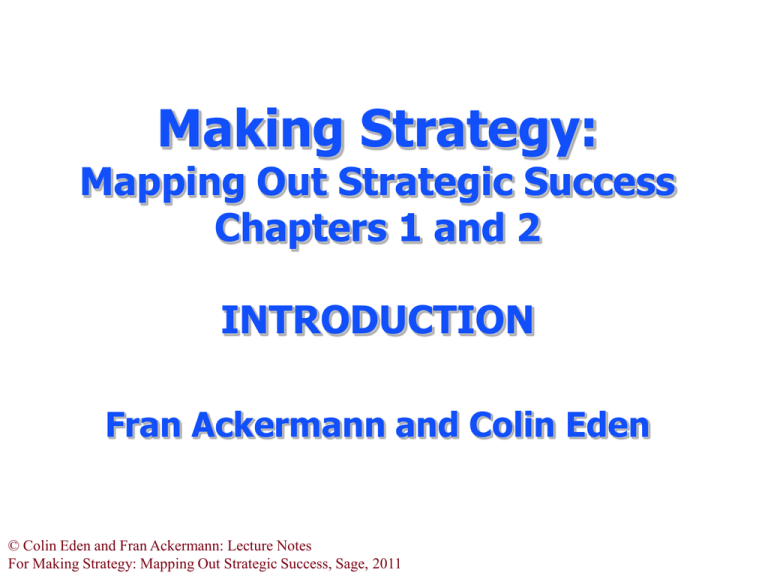
Making Strategy: Mapping Out Strategic Success Chapters 1 and 2 INTRODUCTION Fran Ackermann and Colin Eden © Colin Eden and Fran Ackermann: Lecture Notes For Making Strategy: Mapping Out Strategic Success, Sage, 2011 Please note, these slides are designed to be used in addition to the book: Making Strategy: Mapping Out Strategic Success. by Ackermann & Eden, Sage, 2011 They are not designed to be used in a ‘stand-alone’ manner, or to replicate theory and practice presented in the book. The assignment design represents one possibility for a 20 credit MBA course (thus each of the 4 parts represents approx 5 credits + Closure). © Colin Eden and Fran Ackermann: Lecture Notes For Making Strategy: Mapping Out Strategic Success, Sage, 2011 ‘Making Strategy’ aims to… Help you, as a manager with the involvement of your ‘top team’, (or the TMT) determine the strategic priorities that will gain your dept gain competitive advantage. Become strategic thinkers and managers. Use methods and tools employed successfully in public and private, large and small, national and international organizations. Enable the use of the process with regard to its flexibility and inclusiveness, ensuring that the priorities are based on sound data, are widely understood, and have the commitment of a dominant coalition within the MT. © Colin Eden and Fran Ackermann: Lecture Notes For Making Strategy: Mapping Out Strategic Success, Sage, 2011 What will happen? Cycle between ‘lectures’ and group work Create a strategy for the future success of the organisation – not-for-profit or for-profit ‘Submit’ the assignment as the seminars unfold • Assignment details are provided in a separate pack of slides Complete a ‘peer assessment’ form © Colin Eden and Fran Ackermann: Lecture Notes For Making Strategy: Mapping Out Strategic Success, Sage, 2011 What is strategy? Strategy is about agreeing where to focus energy, cash, effort, emotion © Colin Eden and Fran Ackermann: Lecture Notes For Making Strategy: Mapping Out Strategic Success, Sage, 2011 What is strategic management? Implementing the agreements about where to focus energy, cash, effort, emotion © Colin Eden and Fran Ackermann: Lecture Notes For Making Strategy: Mapping Out Strategic Success, Sage, 2011 Strategic Management is about agreeing where to practically focus energy, cash, effort, emotion © Colin Eden and Fran Ackermann: Lecture Notes For Making Strategy: Mapping Out Strategic Success, Sage, 2011 Strategic Management is about making things happen that will have desirable outcomes for the sustainable success of the organization Implies understanding the nature of success for this specific organization (goals and competitive advantage) and understanding causality of deliberate actions to create outcomes (means-ends) © Colin Eden and Fran Ackermann: Lecture Notes For Making Strategy: Mapping Out Strategic Success, Sage, 2011 Making Strategy in 4x~3hr workshops (2 days)…. Or single half day workshops Workshop 1 – morning • Strategy as the Prioritisation and Management of Key Issues • Statement of Strategic Intent Workshop 2 – afternoon • Strategy as Purpose: Agreeing Goals and Aspirations for the Organisation • Statement of Strategic Intent Workshop 3 – morning • Strategy as Competitive advantage • Statement of Strategic Intent Workshop 4 – afternoon • Strategy as Stakeholder Management • Statement of Strategic Intent DELIVERABLE OVERALL: • Statement of strategic intent (SSI) encompassing: issue management, purpose, competitive advantage, stakeholder management © Colin Eden and Fran Ackermann: Lecture Notes For Making Strategy: Mapping Out Strategic Success, Sage, 2011 Resources: “Making Strategy: Mapping Out Strategic Success” Ackermann & Eden Sage 2011 Other Resources • Course Powerpoint handouts • Decision Explorer (downloaded via Sage web site on purchase of book) • Key commands in Decision Explorer (2pp) – VERY IMPORTANT to have available while undertaking the seminars [available on the web site] © Colin Eden and Fran Ackermann: Lecture Notes For Making Strategy: Mapping Out Strategic Success, Sage, 2011 What you need: To be a member of a small group of 3-5 persons Decision Explorer downloaded and installed [Use a Mouse for operating DE, not a trackpad. It is much easier!] © Colin Eden and Fran Ackermann: Lecture Notes For Making Strategy: Mapping Out Strategic Success, Sage, 2011 Making strategy: Refer to Chapter 2 Commitment to delivering strategy is almost more important than the results of analysis But, there need not be a conflict, as long as commitment from the power brokers is held to be paramount. The power brokers, possibly a management team, are a social group. Agreeing strategy is thus a social and psychological negotiation (changing minds and relationships). Good analysis must inform this negotiation where possible. However, managing the negotiation to achieve emotional and thinking (cognitive) commitment drives making strategy. The designed social process, the ‘journey’, is what can determine commitment. Negotiation that can lead to consensus, rather than compromise, requires a number of important features: • Start from 'where each participant is at' - their immediate and personal/role concerns • Seek to develop new options rather than fight over 'old' options • Attend to 'procedural justice' • Use a 'transitional object' - a picture/ model that is equivocal (fuzzy but meaningful) and changing, and that encourages shifting of positions © Colin Eden and Fran Ackermann: Lecture Notes For Making Strategy: Mapping Out Strategic Success, Sage, 2011 Refer to Chapter 2 and appendix Decision Explorer as a ‘Transitional Object’ to facilitate negotiation ‘Post-Its’ work as a crude transitional object, but... We rarely rewrite and so not in transition! Anonymity is unlikely Problematic to ‘play’ with the data Difficulty moving data around to look for new patterns Impossible to conduct analyses of complex causal networks ‘Means-ends’ links do not move with new configurations No organizational memory Difficult to provide continual records of transition SUCCESSFUL NEGOTIATION DEPENDS ON ALL OF THESE ASPECTS HOWEVER – SHOULD BE SO THAT ALL CAN EASILY SEE © Colin Eden and Fran Ackermann: Lecture Notes For Making Strategy: Mapping Out Strategic Success, Sage, 2011 Your ‘simulation’… You are the strategy making team of one of your group members ‘organization’ (dept, division etc) Address yourself to a part of your organisation over which you have some influence (manager of a dept or division, or in a position of power with respect to a manager) Or, alternatively as a start up group with a ‘business idea’ Each group member must have a realistic but imagined designated role within the ‘organization’ (as if just hired by the organization) © Colin Eden and Fran Ackermann: Lecture Notes For Making Strategy: Mapping Out Strategic Success, Sage, 2011 Getting Started… Decide which part of the organisation the strategy is to be developed With a realistic view of where you can intervene: Define the boundary of your ‘organization’ (dept, group, division, operating company, etc) Agree the strategy making team: Choose a ‘client’ and key power brokers in the organization who will form the strategy making team You will count yourself among this group, indeed you may also be the ‘client’ within your group NOTE: IN THE SIMULATION YOU ARE LIKELY TO HAVE LITTLE CONTROL OVER THE SELECTION OF THIS TEAM © Colin Eden and Fran Ackermann: Lecture Notes For Making Strategy: Mapping Out Strategic Success, Sage, 2011 Your task… Decide on organization and work out roles (stay within your own expertise as a new member of the team) © Colin Eden and Fran Ackermann: Lecture Notes For Making Strategy: Mapping Out Strategic Success, Sage, 2011
